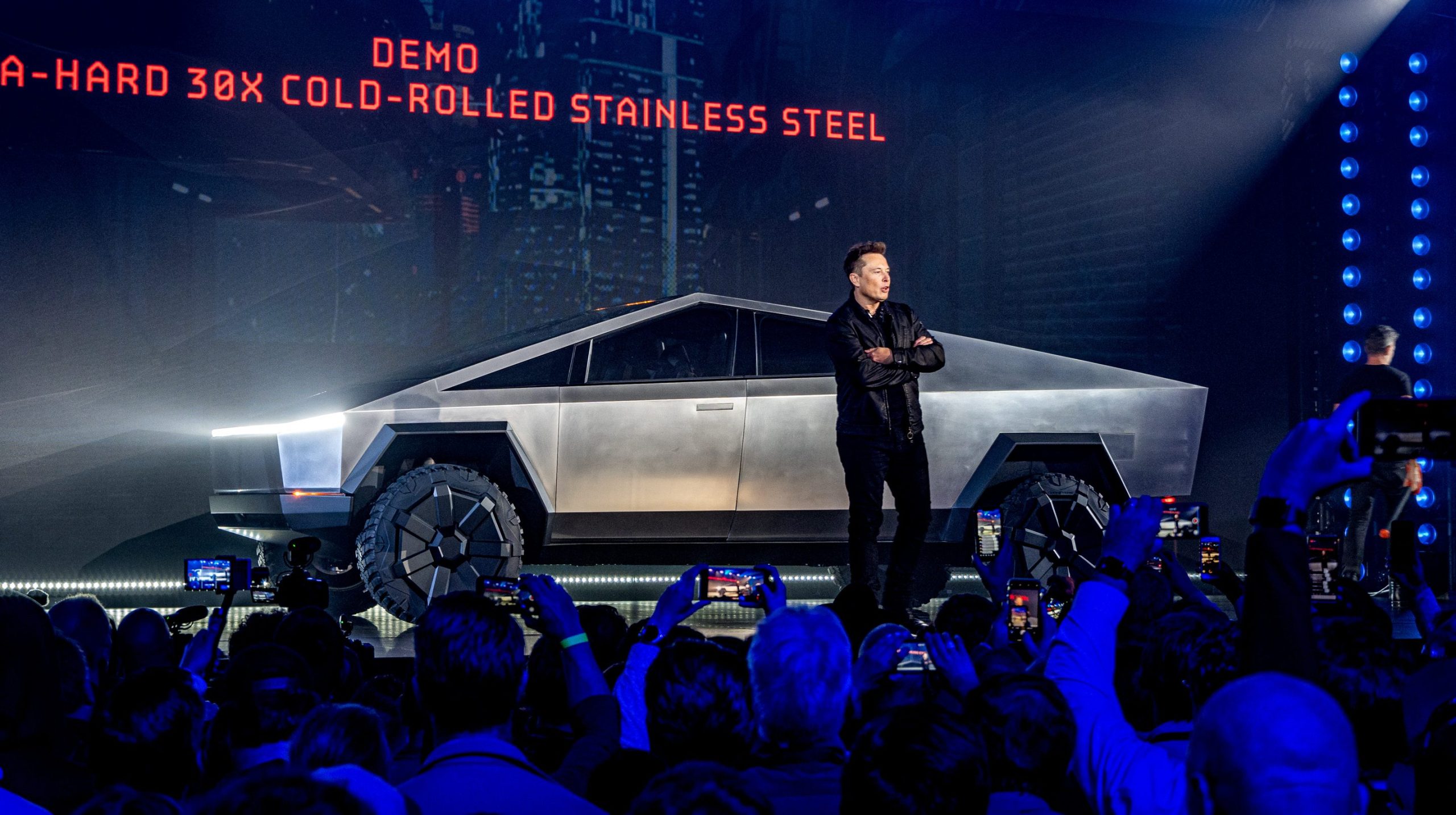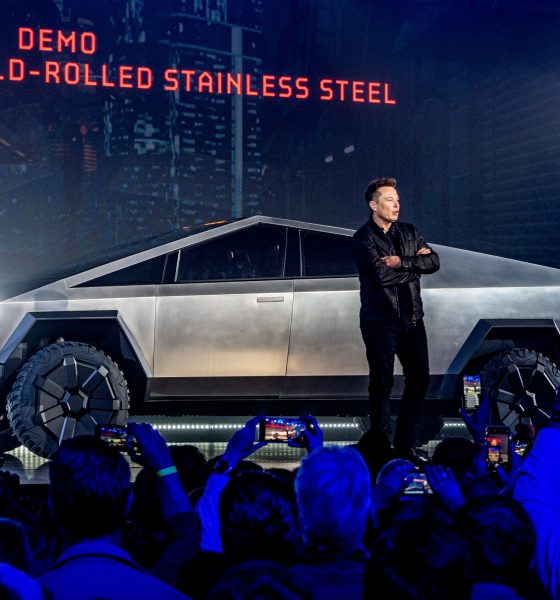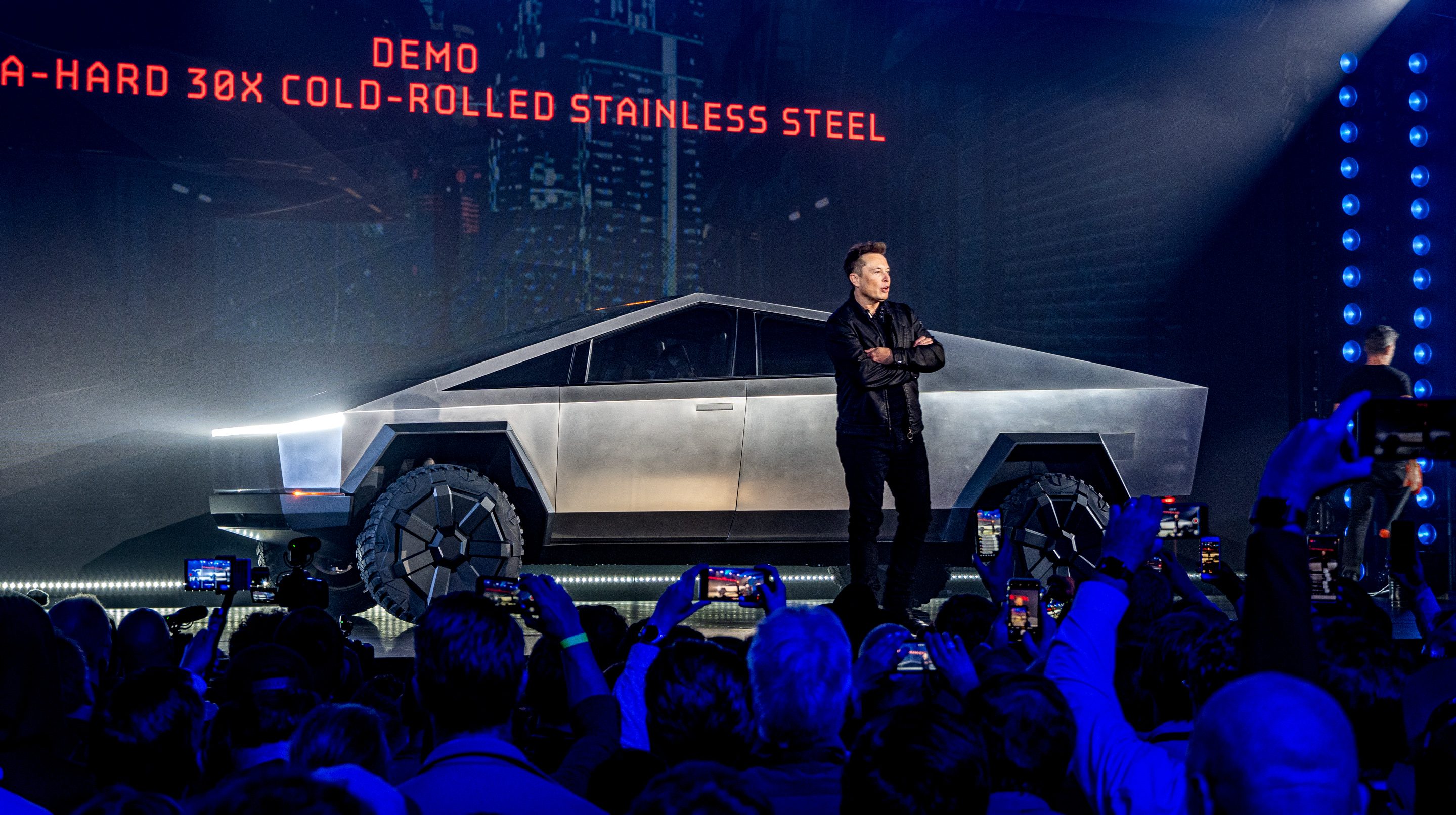

News
Tesla’s Elon Musk details Cybertruck design adjustments with Joe Rogan
Tesla CEO Elon Musk broke down some of the modifications that Tesla made to the design of the Cybertruck during his third podcast appearance on the Joe Rogan Experience. Musk indicated in November that Tesla would be redesigning the Cybertruck slightly, giving some “small improvements” to the initial design after some concerns over the size of the vehicle.
Tesla Cybertruck
Tesla unveiled its Cybertruck in November 2019 with a futuristic, Cyberpunk-themed event at SpaceX headquarters in Hawthorne, California. Musk, along with Tesla’s Chief Designer Franz von Holzhausen, unveiled the truck on stage, displaying its polarizing design and effectively indestructible steel exoskeleton.
Combined with bulletproof glass, the Cybertruck is the ultimate apocalypse vehicle, but there were some interested in the all-electric pickup size. Concerns over whether the vehicle would fit in a residential garage or in regular parking spaces were of major importance to some pre-orderers. In fact, a Supercharging site in Los Angeles actually gave design blueprints for Cybertruck-specific charging spaces that would be capable of fitting the massive truck.
Tesla finally finalized the design of the Cybertruck recently. During the Q4 2020 Earnings Call, Musk said that the company was finished making revisions to the design.
Musk stated:
“So we finished almost all of the Cybertruck engineering. So we’re no longer iterating at the design center level or design level. We’ve got the designs fixed.”
Tesla CEO Elon Musk unveils futuristic Cybertruck in Los Angeles, Nov. 21, 2019 (Photo: Teslarati)
Musk: Cybertruck has around 3% size reduction
New design photographs never were released by Tesla or Musk, but in the latest episode of the Joe Rogan Podcast, Musk detailed some of the changes that were made.
He told Rogan:
“That’s pretty much what it [the Cybertruck] will look like, with very small differences. You know, we adjusted the size a few percent. Like around 3% or smaller. You don’t want it to be a couple of inches too big for the tunnel.”
Rogan then asked if the revisions were based on the Boring Company’s tunnel, which Musk took Jay Leno through on an episode of MSNBC’s “Jay Leno’s Garage.” Musk said that the Cybertruck’s fit in the Hawthorne tunnel was “pretty snug,” which could have ultimately led to the revisions.
Tesla Cybertruck makes a tight squeeze through Boring Company tunnel
Cybertruck Production
Musk confirmed to Rogan that the production of the Cybertruck would have limited production at the end of 2021, and volume production “hopefully next year.” Musk indicated on the company’s recently-held Q4 2020 Earnings Call that the Cybertruck could be subjected to some delays.
He said:
“If we get lucky, we’ll be able to do a few deliveries toward the end of this year, but I expect volume production to be in 2022.”
Rogan’s full podcast with Elon Musk is available here.

News
Tesla FSD fleet is nearing 7 billion total miles, including 2.5 billion city miles
As can be seen on Tesla’s official FSD webpage, vehicles equipped with the system have now navigated over 6.99 billion miles.

Tesla’s Full Self-Driving (Supervised) fleet is closing in on almost 7 billion total miles driven, as per data posted by the company on its official FSD webpage.
These figures hint at the massive scale of data fueling Tesla’s rapid FSD improvements, which have been quite notable as of late.
FSD mileage milestones
As can be seen on Tesla’s official FSD webpage, vehicles equipped with the system have now navigated over 6.99 billion miles. Tesla owner and avid FSD tester Whole Mars Catalog also shared a screenshot indicating that from the nearly 7 billion miles traveled by the FSD fleet, more than 2.5 billion miles were driven inside cities.
City miles are particularly valuable for complex urban scenarios like unprotected turns, pedestrian interactions, and traffic lights. This is also the difference-maker for FSD, as only complex solutions, such as Waymo’s self-driving taxis, operate similarly on inner-city streets. And even then, incidents such as the San Francisco blackouts have proven challenging for sensor-rich vehicles like Waymos.
Tesla’s data edge
Tesla has a number of advantages in the autonomous vehicle sector, one of which is the size of its fleet and the number of vehicles training FSD on real-world roads. Tesla’s nearly 7 billion FSD miles then allow the company to roll out updates that make its vehicles behave like they are being driven by experienced drivers, even if they are operating on their own.
So notable are Tesla’s improvements to FSD that NVIDIA Director of Robotics Jim Fan, after experiencing FSD v14, noted that the system is the first AI that passes what he described as a “Physical Turing Test.”
“Despite knowing exactly how robot learning works, I still find it magical watching the steering wheel turn by itself. First it feels surreal, next it becomes routine. Then, like the smartphone, taking it away actively hurts. This is how humanity gets rewired and glued to god-like technologies,” Fan wrote in a post on X.
News
Tesla starts showing how FSD will change lives in Europe
Local officials tested the system on narrow country roads and were impressed by FSD’s smooth, human-like driving, with some calling the service a game-changer for everyday life in areas that are far from urban centers.

Tesla has launched Europe’s first public shuttle service using Full Self-Driving (Supervised) in the rural Eifelkreis Bitburg-Prüm region of Germany, demonstrating how the technology can restore independence and mobility for people who struggle with limited transport options.
Local officials tested the system on narrow country roads and were impressed by FSD’s smooth, human-like driving, with some calling the service a game-changer for everyday life in areas that are far from urban centers.
Officials see real impact on rural residents
Arzfeld Mayor Johannes Kuhl and District Administrator Andreas Kruppert personally tested the Tesla shuttle service. This allowed them to see just how well FSD navigated winding lanes and rural roads confidently. Kruppert said, “Autonomous driving sounds like science fiction to many, but we simply see here that it works totally well in rural regions too.” Kuhl, for his part, also noted that FSD “feels like a very experienced driver.”
The pilot complements the area’s “Citizen Bus” program, which provides on-demand rides for elderly residents who can no longer drive themselves. Tesla Europe shared a video of a demonstration of the service, highlighting how FSD gives people their freedom back, even in places where public transport is not as prevalent.
What the Ministry for Economic Affairs and Transport says
Rhineland-Palatinate’s Minister Daniela Schmitt supported the project, praising the collaboration that made this “first of its kind in Europe” possible. As per the ministry, the rural rollout for the service shows FSD’s potential beyond major cities, and it delivers tangible benefits like grocery runs, doctor visits, and social connections for isolated residents.
“Reliable and flexible mobility is especially vital in rural areas. With the launch of a shuttle service using self-driving vehicles (FSD supervised) by Tesla in the Eifelkreis Bitburg-Prüm, an innovative pilot project is now getting underway that complements local community bus services. It is the first project of its kind in Europe.
“The result is a real gain for rural mobility: greater accessibility, more flexibility and tangible benefits for everyday life. A strong signal for innovation, cooperation and future-oriented mobility beyond urban centers,” the ministry wrote in a LinkedIn post.
News
Tesla China quietly posts Robotaxi-related job listing
Tesla China is currently seeking a Low Voltage Electrical Engineer to work on circuit board design for the company’s autonomous vehicles.

Tesla has posted a new job listing in Shanghai explicitly tied to its Robotaxi program, fueling speculation that the company is preparing to launch its dedicated autonomous ride-hailing service in China.
As noted in the listing, Tesla China is currently seeking a Low Voltage Electrical Engineer to work on circuit board design for the company’s autonomous vehicles.
Robotaxi-specific role
The listing, which was shared on social media platform X by industry watcher @tslaming, suggested that Tesla China is looking to fill the role urgently. The job listing itself specifically mentions that the person hired for the role will be working on the Low Voltage Hardware team, which would design the circuit boards that would serve as the nervous system of the Robotaxi.
Key tasks for the role, as indicated in the job listing, include collaboration with PCB layout, firmware, mechanical, program management, and validation teams, among other responsibilities. The role is based in Shanghai.
China Robotaxi launch
China represents a massive potential market for robotaxis, with its dense urban centers and supportive policies in select cities. Tesla has limited permission to roll out FSD in the country, though despite this, its vehicles have been hailed as among the best in the market when it comes to autonomous features. So far, at least, it appears that China supports Tesla’s FSD and Robotaxi rollout.
This was hinted at in November, when Tesla brought the Cybercab to the 8th China International Import Expo (CIIE) in Shanghai, marking the first time that the autonomous two-seater was brought to the Asia-Pacific region. The vehicle, despite not having a release date in China, received a significant amount of interest among the event’s attendees.








